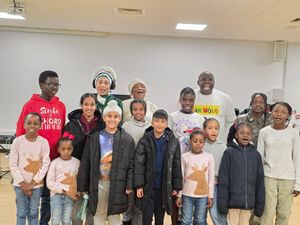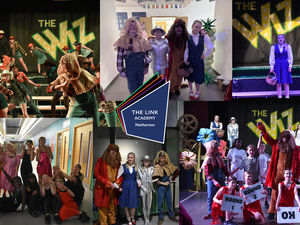RAF Museum Cosford celebrates 10 years since £12.5 million Cold War exhibition - with pictures and video
It is 10 years since the £12.5 million Cold War exhibition at the RAF Museum in Cosford was opened by Princess Anne and former prime minister Baroness Thatcher.
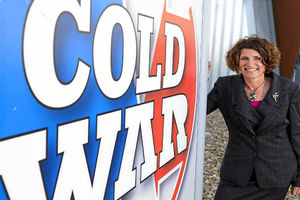
Over that time 3.2 million people have walked through the doors – doubling the number of visitors to the museum and attracting people from all over the country – and some from abroad.
Watch the video here:
Of course, none of this would be possible were it not for the people who keep the operation running smoothly. To mark the anniversary, we spoke to people who perform 10 roles crucial to its success.
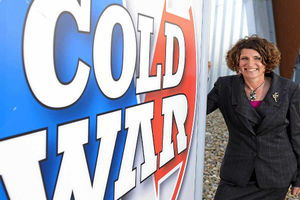
As chief executive of the RAF Museum, Maggie Appleton is in charge of the entire operation.
She took up her post at the end of 2014 and says the key to the Cold War exhibition's success is the way it tells the story of how ordinary people's lives were affected.
"I have got two boys, both doing GCSE history, and the Cold War is now a GCSE topic," says the 51-year-old.
"Coming here is so much better than reading about it in a textbook. It's a great example of how a good museum can hold your interest, whatever your age."
When pressed, Maggie says she has not one but two favourite exhibits, although these appeal for very different reasons. "I like the three V-bombers. The story it tells is really powerful. It is a great story about the RAF, but also people's stories about the time."
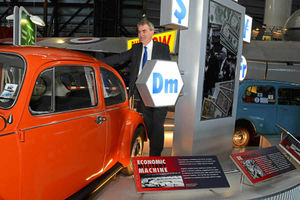
Standing in front of an East German Trabant car is assistant director Paul Pomfrett, who oversees the day-to-day running of the whole Cosford museum site. He took up his post two years ago, but he was already very familiar with the Cold War exhibition.
"I first visited the year it opened, I was living in Scotland at the time so it was some trip, but I remember being blown away when I first visited," he says. "When the chance came to work at the museum, it was a great opportunity for me.
"I have always had an interest in aviation, every since I was little," says Paul, who is 49.
He says visitor numbers at the Cosford site doubled when the Cold War exhibition opened 10 years ago, and this has been maintained ever since.
He believes that much of the interest stems from the way it relates to something still quite fresh in our memories.
"I'm not old enough to remember the start of the Cold War, but I'm certainly old enough to know a bit about that period, and the aircraft both sides had.
"To be able to get up so close to them is a great opportunity."
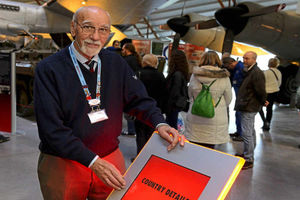
As a child growing up during the Second World War, volunteer John Parsons remembers a fascination with aircraft from a very early age.
"You soon learned to recognise every aircraft by its sound when you heard it flying above," he says.
"It was a very frightening but also a very exciting time for a young boy."
One of his favourite memories was when he took a party of blind veterans on a tour of the museum, and played them a video about the Vulcan bomber. A member of the audience asked him whether it had been filmed at Cosford, and while John attempted to answer, a voice at the front shouted "Wittering".
"Wittering was an airfield in Cambridge and when I asked him how he was so sure, he said if you count the third plane in, it was him flying it. He said it had taken all day to make that film."
John, who is 86, briefly served as a safety pilot with the RAF when doing his National Service in 1949, and began volunteering at the museum when he moved to his home, near Albrighton, in 2000. He typically spends two to three days a week showing people around the museum, including school parties.
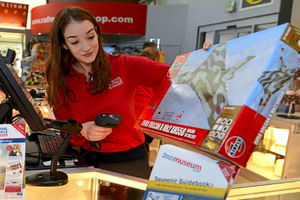
Paige Hodgkiss, 19, from Bilbrook, works in the museum shop.
"I was originally going into the Army, but a back injury meant I wasn't able to do that," she says. "This was a way of still being involved with it, without having to do the physical stuff."
She says the shop can get very busy at times particularly during visits from large school parties, and she loves hearing stories from people who have personal experiences relating to the exhibits.
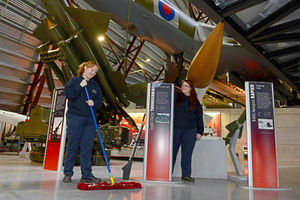
It falls to cleaners Mikaela Stanley and Vicki Hough to keep everything spick and span.
Mikaela, 21, from Telford, says it is really interesting working around such huge exhibits, although keeping such a vast site spotless takes a lot of effort.
"I used to work cleaning an office, and when you do that you are there at night when most of the people have gone," she says. "Working here you speak to more people."
Vicki, 38, is also from Telford, and says she feels a great deal of pride in working at such an important attraction.
She says she had never visited the museum until she started working there three-and-a-half years ago, but has since been several times with her daughter.
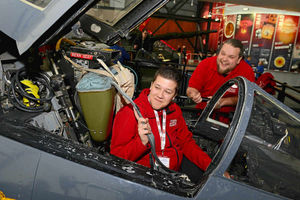
Simon Thomason and Ieuan Moragham are visitor experience assistants at the museum. They are on hand to answer any questions people might have about the exhibition.
Simon, 31, from Quinton, Birmingham, says he sees his work as a tribute to his grandfather Phil Castle, who served with the RAF during the Second World War.
"He used to bring me here as a kid, and tell me all the stories about the war, and it grew from there," he says.
He joined the museum as a volunteer six years ago, and took up his post on the staff just over a year ago, having worked for 16 years in retail.
Sadly, Phil never saw his grandson take up his post at the museum, having died three years ago at the age of 93.
Ieuan, who is 22,
remembers walking around the site as a youngster, when the Cold War exhibition was still being built.
He says one of the things he likes about it is the way it takes visitors through the story in a chronological fashion.
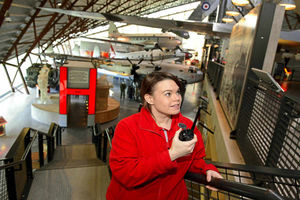
For visitor experience supervisor Sam Barrett, 30, the RAF Museum is in the blood. Her parents, David and Margaret Leek met while working as volunteers at the site in 1980 and married in 1982. David then served as chairman of the Aerospace Museum Society for 15 years before his death at the age of 57 in 2013, and Sam remembers helping them out at the site from the age of about five.
"I think they lowered the age limit so that I could volunteer," she says. "It used to be 14, but they lowered it to 12 for me.
"I can remember when I was about five or six I would help to rub down the engine cowlings on the Lincoln with sandpaper."
Sam now has a 21-month-old son Jack, who is already showing signs of an interest in the museum.
"It would be nice if he wanted to follow in the family footsteps, I wouldn't do any thing to discourage him."
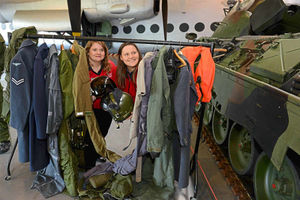
Lily Dean and Mary Wycherley are access and learning officers at the museum, and it falls to them to put on educational activities for the 25,000 schoolchildren who visit the museum every year.
Lily, who is 27, joined the team 18 months ago, and says she really enjoys seeing the way the children respond to the exhibition.
"I'm really passionate about education," she says.
"We talk to our schools a lot about the advances in technology and how the Cold War really pushed that on as the powers competed with each other."
Mary, 32, says
part of the exhibition's success is down to the variety of the exhibits.
"There is something for everyone, and there is always something interesting going on."
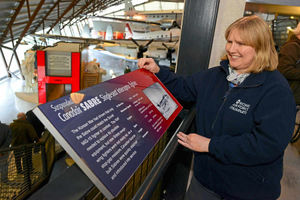
Assistant curator Clare Carr has been with the museum for 20 years and remembers the anticipation that surrounded the new exhibition during the months before it opened.
"There was a lot of talk that Margaret Thatcher was coming, and there were even rumours that Gorbachev was going to come, although that never happened," says the 45-year-old from Telford. Her work involves helping to organise the collections and putting the text together for the information kiosks around the site. I'm told there are more words in the information kiosks than there are in the Bible, something like 800,000 words," she says.
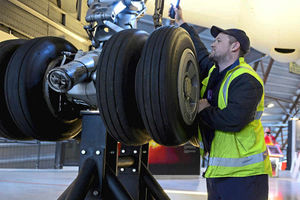
Technician Dave Tymon was one of the staff members greeted by Princess Anne when she performed the official opening of the museum 10 years ago.
"My mum was there," he recalls with a smile. "She pushed her minder out of the way to get a picture."
The 28-year-old
says a lot of his work involves ensuring the planes are safe for the public to view. This can involve checking radiation levels, and ensuring that none of the components are likely to fail. "It can be very physical work," he says.


